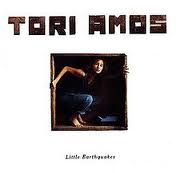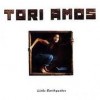 Originally published by L.S. Media. September 2nd 2012.
Originally published by L.S. Media. September 2nd 2012.
In 1992 Tori Amos released her debut solo album Little Earthquakes and in amongst the battle ground between the dying days of 1980’s preening rock stars, the new wave of grunge and the coming of so called super celebrity music. The music, always evolving always up for musical comment and commitment to the latest music cause looked to dragging out in a three way battle that ultimately has led to none being hailed as loudly as Tori Amos, the first woman of 1990’s music.
Trailblazing, eccentric, eclectic, golden forward feminist thinker and all round talented musician wrapped up in a career that has stretched back over 20 years and sees her in 2012 as one of the leading women in all areas and genres of music. In 1992 though, Tori Amos was either on the verge of being hailed a critical success or yet another Kate Bush clone. Her 1998 self-titled album as part of the synth-pop band Y Kant Tori Read, although a decent enough album to listen to, didn’t really set the world on fire and beset by problems that could have deterred a lesser spirit.
In the intervening four years, Tori changed the way that women were looked at in the music world. In very much the same way that Billie Holiday changed the awareness of women in the male dominated Blues era, Tori took on the world with perhaps an unconscious thought to show that women in contemporary music didn’t have to be seen as submissive, almost pawn like to the male record executives and public perceptions of how women were supposed to write and perform music.
Little Earthquakes owes much to the confession poets of America, the likes of Anne Stevens, Syvia Plath and Robert Lowell., the lyrics and musical styling certainly wouldn’t have been out of place in the realms of Anne Stevens own poetry. The confession of the sexuality of women, the demanding of attention of the lyrical basis to the words as well as Tori’s trademark piano are there to be heard and more importantly felt and revelled in and if not understood then at least appreciated.
The album starts off with the dramatic Crucify, a song which explodes onto the subconscious of the listener. The opening confessional emotion of the first line that, “Every finger in the room was pointing at me”, gives the listener the thought of accusation, the intensity of feeling abused by your peers, whether rightly or wrongly, is something every person can at least equate to but it is never talked about. Like the confessional poetry of the American poetic soul, Tori immediately has the sensitivity, the creative genius to make any one hearing her piano and voice feel for her, fall in love with her and be co-conspirators in her desire to see a more equal world.
The world of 1992 was changing, a pivotal point in American politics that would lead to, for at least a while, a more calmer America, less reactionary as like the period of John F. Kennedy in the 1960’s there was more emphasis on trying to sort out the internal problems that persisted in the United States that the previous Presidents had eluded to. This change, though not straightforward politically except in gender politics can be seen in the songs of Ms. Amos. This was the first woman of the new period to take full advantage of the new thinking, where Grunge had the poetry of the late Kurt Cobain to contain it; there really had been nothing for a long time to recognise how women should be really seen as musical artists. At the time, with very few exceptions coming from Great Britain, there was no one who spoke to women and made men sit up and listen as well.
Crucify is dynamic, the video that went hand in hand beside it held up the ideal of Ann Boleyn as s strong female icon who was wronged by society. This allegory may sit uncomfortably with some but it could be seen as an inspired piece of social commentary on the situation of women in America and in music, the thought that once you get past a certain age or if having thoughts of your own were somehow dangerous to the previous thinking.
In Crucify, Tori eludes to thought of religion and victimhood, the need for a saviour and the idea that like Christianity itself, it requires a victim to confess their sins for the world to be able to move on.
Arguably one of the finest songs on the album is Silent All These Years, the expression of self grief of not having the right courage to speak out about any abuse. The thought of being able to change places with someone, not so they could suffer the abuse themselves but ultimately being able to give that person the courage to walk away and be strong, something that the abused would love to be able to hear. It is a song that defines strength and being able to be heard. It also defines the album and Tori Amos herself. Not taking the knock back from Y Kant Tori Read. It made her stronger, it defined her as a woman of musical substance and brought her style to the masses.
The thought of female sexuality is never far from the themes of the album and is perhaps typified in the two previous songs and in the beautiful but haunting Leather. The song starts unconventionally for the time with the words, “Look, I’m standing naked before you, “Don’t you want more than my sex? “ This challenge to men to see women as more than figures of want and sexual desire, to realise that to possess a brain that is creative, strong and vibrant is more than important than the allure of flesh is more personally gratifying that the cynical use of women prescribed by certain bands and genres in the previous decades.
For a debut album, they don’t come much better than Little Earthquakes. It started a long process of inspiring women to come to the fore in the last 20 years and it despite the air of sweetness in her voice, it is a authoritative musical narrative that is required listening.
Ian D. Hall
